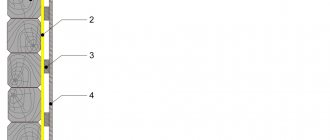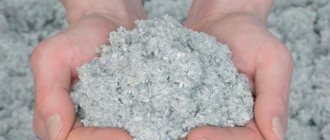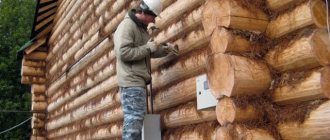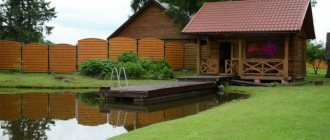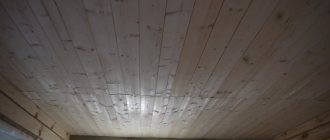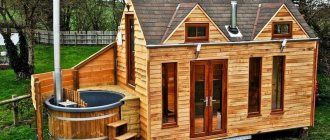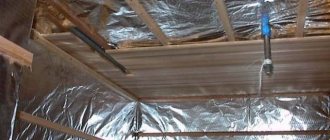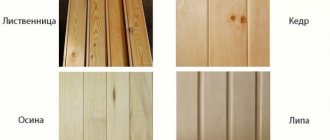- From timber
When setting up a steam room, it is very important to take care of the quality of its thermal insulation. Therefore, today we will tell you how to insulate walls in a bathhouse from the inside. Let's consider what materials to choose depending on the nature of the structure, what technology is used to lay them and the rules followed. Let us immediately note that it is ineffective to carry out such work outside the building, no matter what it is made of, timber, concrete or brick.
Advantages of internal insulation
- Reduces fuel consumption (either solid fuel, such as wood or coal, or gas) and reduces heating time.
- It is the key to the desired microclimate in the steam room. You will forget about drafts, dampness, cold, and you will be able to feel comfortable in any season.
- Ensures proper circulation of hot air, preventing condensed moisture from settling on various surfaces of the rooms. Thanks to this, the cladding remains dry, resists mold and fungi, does not rot, does not deteriorate longer and looks beautiful in a new way.
The best insulation for baths and saunas in the mid-price segment
Glass wool
It is a yellow insulation material made from sand, soda, dolomite, limestone, borax and broken glass. All these components are placed in a special container, where they are heated to 1400 C. As soon as the mass is melted, it is passed through filters in a centrifuge, where it is blown to obtain the finest glass threads.
The material is treated with a polymer binder, and the result of this process is subjected to molding and blowing at a temperature of 250 C. The latter is necessary for drying and the formation of polymer bonds. The finished product takes on an amber-yellow color.
glass wool insulation
Advantages:
- lightness;
- high thermal conductivity;
- resistant to chemicals;
- does not burn or smolder;
- does not shrink even after many years;
- vibrations do not destroy fibers.
Flaws:
- brittle fibers;
- it is necessary to work with it exclusively in special clothing and a respirator, otherwise it can cause harm to the respiratory and visual organs;
- low moisture resistance.
Basalt insulation
It is made from the rock of the same name. To do this, it is melted to a viscous state and, using a powerful stream of air, the fibers are blown out. Then they are intertwined and fastened together with arbide-urea resins. They are completely harmless. Their number does not exceed 5% of the total mass. Then the resulting mass is sent for pressing.
The production of basalt insulation can be compared to the production of cotton candy. This is the leader among thermal insulation materials on the market. This was facilitated by the environmental friendliness of the material, which is distributed in rolls, plates and cylinders.
Basalt insulation
Advantages:
- does not emit compounds harmful to the body;
- almost 95% of the composition is volcanic rock, which makes this insulation as natural as possible;
- minimum number of connecting elements;
- vapor permeability reduces the risk of condensation and the formation of microorganisms harmful to the body;
- operation for 30 years;
- does not burn;
- does not attract the attention of rodents;
- retains its shape even under the influence of aggressive environments;
- high sound insulation performance.
Flaws:
- heavy weight;
- quality depends on the production technology of a particular manufacturer.
Foil insulation
This is a two-layer material in which the outer layer is made of polished foil or metallized polypropylene film. This solution increases efficiency by 97%.
IR radiation hitting a reflecting surface is reflected, but part of the heat is transferred by convection through the air. Due to this, the foil heats up and transfers heat. The aluminum film passes it through itself onto the heat insulator. The thermal insulation qualities depend on the material placed under the film. Aluminum film is only needed to reflect IR rays. To do this, use a layer of air measuring 20 mm.
As a rule, foil heat insulators are used in steam rooms, since there is strong IR radiation from the stones. Aluminum retains moisture and steam. Only aluminum foil is used as insulation.
Foil insulation
Advantages:
- the metallized layer provides resistance to moisture and corrosion;
- absorbs noise well;
- reduces fuel costs;
- maintains an acceptable temperature for a long time;
- flexible;
- light weight;
- contains no toxic substances;
- Even a beginner can handle the installation work.
Flaws:
- insulation cannot be mixed with building mixtures;
- low anti-corrosion resistance.
Which insulation is better depending on the type of building
When choosing insulation for the walls of a bathhouse, it is important to consider what material it is built from.
From timber
In the case of a durable type of wood and a relatively large cross-section of each element of the frame, it is enough to simply caulk the cracks and treat the walls with impregnations against fungus and mold, as well as compounds that protect against moisture and fire.
In other situations, all rooms (especially the steam room) must be insulated with basalt wool - in one layer, using the “Pie” technology (we will consider it separately below), additionally laying foil material to minimize the harmful effects of steam.
Made of brick
It freezes quickly in the cold season. This means that measures need to be taken to ensure that a suitable microclimate inside is maintained even in the harshest winter. To do this you can:
- install second walls around the entire perimeter;
- or make a double thermal insulation layer.
To create the sheathing, it is better to use wood rather than metal, since the latter gets very hot during operation. Naturally, it is recommended to treat the prepared structure with agents against fire, rotting, and insects.
Made from concrete
In this case, you can insulate the walls in the steam room of the bathhouse from the inside and outside. Such a serious approach will result in the absence of problems with the masonry getting wet (due to condensed steam), and will become a measure that effectively prevents rapid destruction.
Here the craftsman upholsters the surfaces in the room with 10 cm thick mineral wool (or an analogue suitable in structure), and from the street he arranges a hinged ventilated facade, that is, he fixes the same basalt sheets and covers them with clapboard or siding. The method is relatively expensive, but it guarantees the correct microclimate.
Made from expanded clay concrete blocks
Here you will also need moisture-resistant material, but in combination with high-quality hydro- and vapor barrier. Plus, it is worth installing additional ventilation - this will help level out the increased level of humidity. It is quite acceptable to lay foil tape in as thin a layer as possible.
Why is thermal insulation needed?
Thermal insulation of a sauna is a mandatory measure to ensure optimal heating of the indoor air, avoiding high temperature ranges between the steam room and the dressing room, maintaining stable steam and protecting visitors from drafts. In addition, good thermal insulation saves resources for heating the room and increases its service life by providing additional insulation from negative factors: fire, moisture, harmful microorganisms. How to properly insulate a door
The door to the bathhouse serves as a barrier through which the cold should not penetrate into the room. This can be due, firstly, to its design - the doors from the street to the dressing room and from the dressing room to the steam room are usually made wide, low and with a threshold under them. Due to thermal expansion, the cold tends to occupy a lower position than the already heated air. This door design prevents drafts from entering and retains more heat in the bathhouse.
Secondly, to insulate a door, several methods of modernizing it can be used. You can implement them yourself using step-by-step instructions:
- The first method is an additional frame with insulation. Synthetic fabrics are used here as insulation; you can even get them from old coats or toys. A strip of bars up to 2 cm thick is nailed to the door, and to it is a double-folded insulation roller on small aluminum nails. If desired, a sheet of hardboard can be laid inside the frame as additional insulation. This is the simplest and cheapest method that will prevent drafts from entering the bathhouse and steam leakage from the room, however, the insulation will have to be changed regularly (at least once a year) if a material inert to moisture and mold has not been chosen for it.
- Another way is to insulate the entire surface of the door with energyflex (pipe insulation). To do this, it is enough to cover the inside of the door with material, fix it around the perimeter with a construction stapler, and stuff metal slats on top for greater stability.
- The third method is to design a thermal curtain. Such structures are either made to order in specialized stores or constructed independently without special technical knowledge. For a thermal curtain, you must first make a sealing frame around the door, which will create a gap between it and the curtain itself. The frame is made of soft non-flammable sealant and wooden blocks. An additional bar is installed along the top of the frame - a cornice, on which curtain rings are hung. The curtain itself should be made of dense and durable material - preferably tarpaulin. You need to sew hooks onto it that will secure the curtain to the frame when closing. This design will keep heat and moisture inside, while leaving the door dry.
These methods will protect the door from swelling and prevent temperature changes inside the bathhouse, and leave the dressing room warm and dry.
How to properly insulate the walls of a bathhouse from the inside
First, let's talk about the general principles. According to them, the greatest attention should be paid to the key rooms - the steam room and the wash room. All calculations - the quantity and volume of components - should be carried out with a reserve, that is, taking into account rough consumption. It is better to immediately refuse cheap impregnations, compositions, solutions - this is the case when it is better to spend money, but make a decision for the long term, because if repairs are needed soon, you will overpay much more than you saved.
When choosing a material, you need to choose one that has the following characteristics:
- non-toxic and environmentally friendly;
- low hygroscopicity;
- resistance to high temperatures and steam;
- the ability to maintain shape for a long time and restore it after physical stress;
- fire-fighting properties.
What effect does a bath have on the human body?
The healing effect of the bath on the body has been noticed for a long time. In those days, healers and healers prescribed steaming for patients of varying degrees of complexity (from mild colds to cardiovascular ailments). Temperature conditions and compliance with certain recommendations of experienced specialists allow you to achieve results in a short time.
Effect on the body:
- The cardiovascular system. Staying in a sauna increases your heart rate by 70% (100 - 160 beats per minute). They increase significantly when steaming with a broom and decrease when doused with cold water. All this causes a restructuring of the circulatory system, especially for those who visited it for the first time. Subsequent visits have a training effect.
- Respiratory system. Healing steam stimulates the functioning of the respiratory system. The resulting effect can be compared to inhalations in a hospital. To achieve maximum results, steam is saturated with various types of herbs. Hot air cures a runny nose, reduces swelling of the mucous membrane and nasal discharge. In the bathhouse, the immune system is strengthened, and positive dynamics are observed in those suffering from chronic respiratory diseases. Regular visits will relieve hoarseness, cough and even reduce noise in the lungs.
- Nervous system. Reduced blood flow in the brain leads to a decrease in emotional activity, as well as a drop in muscle and mental tension. The bathhouse has a beneficial effect on the emotional state. After visiting her, a person leaves with anxiety and headaches. Violation of the bath regime leads to headaches, dizziness, sleep disturbances and feelings of anxiety. Despite the fact that the bathhouse is a great stress for the body, most people tolerate visits without problems.
- Musculoskeletal system. Heat has a beneficial effect on muscles and joints. Visiting the bathhouse is preferable for patients with rheumatism, gout and arthrosis. You should only take a steam bath after consulting with an experienced doctor.
- Leather. Increased sweating is accompanied by the movement of substances from the tissue into the blood. This is accompanied by a decrease in swelling. Heat has a beneficial effect on the regeneration of epidermal cells and improves metabolic and immune functions. Bath procedures remove dead particles and skin secretions from the face, and also regulate the functions of the sebaceous glands. Steam removes sweat, grease and dirt. In the steam room, the first small wrinkles are smoothed out, and the skin acquires a healthy and beautiful shade.
“Pie” insulation technology
It is called so because, upon completion of the work, the wall is covered with several layers at once: thermal insulation, vapor barrier, cladding. You should start from top to bottom.
First of all, attach the bars to the load-bearing surfaces - at a distance from each other 1 cm less than the width of the mineral wool. Having created the frame in this way, you mount basalt slabs on it by surprise - carefully, without crushing the edge, ensuring a tight fit. Do not forget that gaps are places where moisture accumulates and “cold bridges” form.
Cover the resulting structure with a vapor barrier, so that its foil side faces the inside of the room, and be sure to seal all joints and seams with special tape. Then you perform the sheathing - directly on the wood of the still protruding base, at a distance of 5-10 cm from the previous layer. This way you will create a buffer zone in which the condensate will drain without coming into contact with the lining and without subjecting it to rot. And to finish, close the “Pie” with the lining.
LOGICPIR Bath from TECHNONICOL: product characteristics
LOGICPIR Bathhouse from TECHNONICOL is an insulation material made from rigid polyisocyanurate foam with a closed cell structure. The top and bottom are covered with aluminum foil, which provides it with increased sound and heat insulating properties. The insulation is produced in Russia.
Main characteristics in the table.
Thanks to the special shape of the edge, LOGICPIR Bath slabs from TECHNONICOL fit tightly together, which minimizes the likelihood of gaps. For greater sealing, it is recommended to glue them along the seams with metallized tape.
Foil-coated PIR boards have high insulating properties, so they can be installed in both dry and wet areas. LOGICPIR Bath from TECHNONICOL is a material that is designed for installation in a steam room, dressing room and other rooms of bath complexes.
The material is durable. Its service life is more than 50 years. During this time, it does not lose its properties and does not require replacement or additional processing by any means.
A person with minimal knowledge in the field of construction can cope with the installation of LOGICPIR Bathhouse from TECHNONICOL. But before starting work, you need to study the technology, prepare tools and materials.
Ceiling insulation
It is carried out from top to bottom: it is simply more convenient to carry out work in this way, because it is easier to descend systematically than to take on one surface, skip another, and then return to it. It is this order that makes it possible to ensure the same microclimate at every point of the building - there will be no hot or cold zones. True, for this it is necessary to lay the materials overlapping, so that later it is easier to fasten them together.
Craftsmen thermally insulate the ceiling according to the following scheme:
- cover its surface overlapping with roll materials of your choice;
- the bars are mounted, forming a frame;
- place foil on top, covering all connections;
- glue the joints with aluminum tape (several times), evaluate the tightness;
- carry out installation;
- lined with clapboard finished to look like wood.
The best insulation for premium baths and saunas
Penoizol
This material has a wide range of applications. Outwardly, it looks like polyurethane foam. In terms of properties, it has much in common with expanded polystyrene with minor differences: it does not burn and has an acceptable density.
Installation work is carried out using frame technology. In other words, it is first necessary to equip the boards with a special structure, and then the cavity is filled with insulation.
insulation Penoizol
Advantages:
- ease of processing;
- monolithic material without seams or voids;
- does not burn;
- high level of sound insulation;
- not of interest to rodents;
- cavities can be filled through small holes;
- eco-friendly.
Flaws:
- high price;
- installation work requires the involvement of specialists with special equipment.
Foam glass
This is a newcomer to the building materials market, which is rapidly occupying a leading position and attracting more and more attention every day. According to its characteristics, it is head and shoulders above its competitors. The only factor that did not allow it to gain widespread recognition was the high price.
Silicates and gas-forming agents are used in the production of foam glass. The substance is heated to a temperature of 1000 C and foams. When cooled, it acquires unique properties and hardens. It is supplied to markets as sheets, slabs, blocks and granules.
insulation Foam glass
Advantages:
- service life is 100 years;
- environmentally friendly material;
- does not ignite and does not emit substances harmful to the body;
- high strength;
- unfavorable environment for the development of microorganisms;
- does not attract the attention of rodents.
Flaws:
- too expensive;
- low shock resistance;
- heavy weight creates additional stress on the structure.
Floor insulation
The technology is the same, regardless of the coating, concrete or wood. The only difference is the thickness of the pillow. And to control the evenness of the backfill, it is worth first applying markings to the base, conditionally dividing it into meter-long sections. If you plan to isolate the soil right away, then first compact it, cover the supporting surfaces around it with impregnations to protect it from moisture, sprinkle it with a layer of sand (10 cm), fill it with water, cover it with an overlap with roofing material and secure it with tape.
The order of the main work carried out by specialists is as follows:
- laying a vapor barrier film on the base, stretching it so that the edges along the walls are higher than the floor;
- installation of plasterboard profiles or other suitable guides and securing them with screws;
- placement of beacons at the required height in order to further control the level of the pillow;
- pouring expanded clay and leveling it using a slats or rake;
- arrangement of reinforcing mesh, filling it with concrete screed;
- laying the finishing layer.
You also need to know how and with what to insulate the walls of a bathhouse from the inside, not only in the steam room, but also in other rooms. The materials are the same, the general scheme of the wizard’s actions is as follows:
- waterproofing;
- placement of mineral wool;
- vapor barrier;
- finishing the resulting structure with clapboard.
This sequence of work is suitable for a dressing room, rest room and any other room that will not be used in conditions of high humidity and temperature.
To conclude, here are a few useful videos on the topic.
Competent design of a bathhouse is the key to success
In addition to insulating a steam room in a wooden bathhouse, it is necessary to create a competent design of the entire structure.
When developing a project, it is necessary to take the following parameters as a basis:
- First, you need to decide on the size of the bath. To do this, the maximum capacity of visitors and the number of rooms that are planned to be equipped inside the building are taken into account.
- The project itself is created with an emphasis on taking into account all possible losses of thermal energy and minimizing them. For example, the locker room is located at the exit from the bathhouse in order to minimize the access of cold air masses to the main part of the building where the steam room is located.
- A vestibule should be installed between the washing room and the steam room, which will not allow steam to flow into a room with a lower temperature.
- The door in the steam room should not be large, but its junction with the floor should be raised using a special threshold, which does not allow cold air to enter the room.
- The greatest convenience of the steam room is achieved when the room has a square shape. One of its corners is allocated for the installation of a heating furnace. It is advisable that this be the corner closest to the front door.
Also, do not forget that when designing you need to decide on the materials used. If we are talking about how to insulate a steam room in a bathhouse, then artificial or natural materials can be used.
Natural materials are the following types:
- tow - used to seal cracks that are formed when creating a log house or building from wooden beams;
- sphagnum - laid between the crowns;
- building moss is a standard wall insulation.
If the insulation of a steam room in a bathhouse is made with artificial materials, then we are talking about the following varieties:
- extruded polystyrene foam;
- mats made of stone or mineral wool.
Each of these materials has a long service life, a high level of mechanical stability, moisture resistance, etc.
